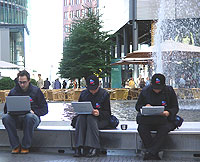The Agency is to carry out a systematic programme of research into wireless local area networks (WLANs) and their use. This will include measurements of exposures from the Wireless Fidelity (WiFi) network and is part of the Agency's ongoing programme of work in the area of electromagnetic fields.
 Professor Pat Troop, Chief Executive of the Health Protection Agency said: “There is no scientific evidence to date that WiFi and WLANs adversely affect the health of the general population. The signals are very low power, typically 0.1 watt (100 milliwatts) in both the computer and the router (access point) and the results so far show exposures are well within ICNIRP guidelines. Given this, there is no particular reason why schools and others should not continue to use WiFi or other wireless networks. However there has not been extensive research into what people's exposures actually are to this new technology and that is why we are initiating this new programme of research and analyses. We have good scientific reasons to expect the results to be re-assuring and we will publish our findings.”
Professor Pat Troop, Chief Executive of the Health Protection Agency said: “There is no scientific evidence to date that WiFi and WLANs adversely affect the health of the general population. The signals are very low power, typically 0.1 watt (100 milliwatts) in both the computer and the router (access point) and the results so far show exposures are well within ICNIRP guidelines. Given this, there is no particular reason why schools and others should not continue to use WiFi or other wireless networks. However there has not been extensive research into what people's exposures actually are to this new technology and that is why we are initiating this new programme of research and analyses. We have good scientific reasons to expect the results to be re-assuring and we will publish our findings.”
WiFi is becoming increasingly widely used in homes, schools, offices and throughout the general working and public environments. People using WiFi, or in proximity to WiFi equipment, are exposed to the radio signals emitted from it and will absorb some of the transmitted energy. From existing information, it would appear that levels of exposure are considerably less than the guideline levels of the International Commission on Non-Ionizing Radiation (ICNIRP) and recommended by the Health Protection Agency for use in the UK . Nevertheless, the Agency considers that WiFi exposure assessment is an area that requires further work.
Given the precautionary advice from England 's Chief Medical Officer and from the Health Protection Agency to discourage the non-essential use of mobile phones by children, it is logical to consider the use of WiFi in schools and in the home. Because of the diversity of available WiFi equipment and the variety of ways in which it might be used, the precise quantification of exposures from WiFi equipment is complex and requires a carefully thought-out approach to assessment.
Following some preliminary work, the Agency now proposes to undertake a research project to measure exposures to radio signals from wireless computer networks. The results will be compared with established international exposure guidelines and also with exposures from other commonly used sources of radio signals, including mobile phones. Discussions are underway with partner Agencies, especially those in the Education sector, regarding the practicalities of carrying out the research.
The findings from the investigation will be published on the Agency's website and submitted for publication in the peer-reviewed scientific literature. The results of the study, and of other studies on radio signals and health, will be used as the basis for a wider health risk review.
Source: HPA press release